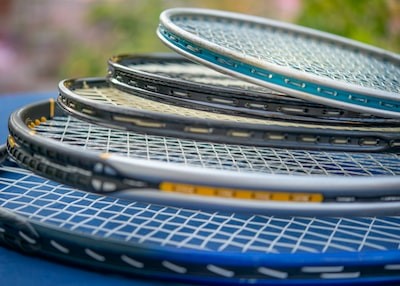Are you tired of constantly changing your tennis racket strings and still not finding the right fit for your game? We have all been there. Tennis racquet strings can make or break your game. In this blog, we will cover everything you need to know about selecting the right type of string that fits your playing style, how tension affects the durability of your racquet, and why it’s important to choose the right tension for different types of players. We will also provide a comparative analysis of synthetic gut vs multifilament vs polyester vs natural gut strings and what impact each type has on your play style. Additionally, we will share tips given by professionals to help you choose the perfect string type for your game. So, let’s dive in and make sure you get the best out of your tennis game!
Understanding the Importance of Tennis Racket Stringing String Type
Recognizing the significance of tennis racket stringing and selecting the appropriate string type in order to enhance your performance on the court. The choice of string can greatly influence your game, impacting factors such as power, control, spin, feel, and responsiveness. It is imperative to comprehend the significance of choosing the right string that aligns with your playing style and personal preferences. The string has a strong impact on the game in terms of power, control, comfort, and spin, which makes the racket-string combination crucial for a tennis player.
Different types of strings offer varying characteristics in power, control, and spin. Monofilament offers a stiff and durable, providing excellent control and spin. Multifilament offer a softer feel and more power, ideal for players seeking comfort and power.
To choose the right string, consider playability, durability, and personal preference. Playability refers to in-game performance, while durability relates to friction resistance. Personal preference ensures comfort and confidence.
Choosing the right strings can enhance your playing style and overall performance. Understand different string characteristics and consider your playing style to find the perfect match. Experimenting with various strings and tensions helps fine-tune your game. Select a string that enhances power, control, spin, feel, responsiveness, and personal preference to optimize on-court performance. Explore options to find the perfect fit for your game.
The Impact of each type of tennis racquet string
Choosing the right string for your tennis racket is crucial. Different types of strings offer unique benefits. Synthetic gut strings provide power and control for versatile players. Multifilament strings offer enhanced comfort, feel, and reduced vibration.
Polyester strings are durable and offer control, making them an excellent choice. They maintain high tension for increased shot control. Natural gut strings provide superior playability but are less durable. They offer exceptional feel and responsiveness. Consider the gauge of the string; thinner strings provide more power and spin, while thicker ones offer control and durability. Understanding the impact of each type helps you make an informed decision that enhances your playing style and performance on the court. Consider your playing style, needs, and preferences when choosing a tennis racquet string.
Effects of Tension with each type of string
Proper stringing of a tennis racket is vital for optimal performance. Increasing the tension improves control and accuracy, while reducing the tension increases power, enlarges the sweet spot, and also influences the racquet’s feel and responsiveness.
Adjusting string tension based on court conditions and personal preference is important. On fast courts with minimal friction, higher tension maintains control. On slower courts with more friction, lower tension generates more power.
Having a good grasp of how tennis racket stringing works and the impact of tension on different types of strings empowers you to make well-informed choices. In our racquet specs table, be sure to check the string pattern section. There you will see the recommended tension range of each racquet, whether it is a one-piece or two-piece racquet, and the main skips. Whether you prefer monofilament for stiffness and durability or multifilament for comfort and feel, finding the right tension optimizes your racquet’s performance. Experiment with different levels to unleash your racquet’s full potential.
When Restringing try other string types
To improve your game, try different string types when restringing your tennis racket. Experimenting with various strings can enhance performance and bring unique benefits. Customize your racket by exploring different types to match your playing style. For more power and spin, use a monofilament string with higher tension. For control and precision, a multifilament string with lower tension works best. Each type has its own characteristics for fine-tuning your racket based on your preferences and needs.
It is advisable to consult with a professional stringer when selecting a new string type. Each time you need your tennis racket stringing done go back to the same place and together you and the stringer can talk out what is going on after each time you have your tennis racket stringing done, they can provide valuable insights based on your playing style and guide you through the available options. Furthermore, they can advise on the appropriate setup for your chosen type as it directly impacts your racket’s performance.
To optimize your performance on the court, do not hesitate to experiment with different string types and seek advice from professionals when restringing your tennis racket. By delving into the world of stringing, you have the opportunity to unlock untapped potential in your game.
Type of String has what Influence on Play Style
The choice of string when doing tennis racket stringing has an impact on power, control, and spin. Various stringing’s are designed to suit different playing styles. It is important to take into account the unique characteristics of each type and how they align with your own style of play. For instance, opting for a monofilament string offers enhanced control but may compromise power, whereas choosing a multifilament string provides increased power and comfort but may sacrifice some control.
Finding the right string is crucial for optimizing your performance. By selecting a string that suits your strengths and preferences, you can maximize power, control, and spin. Experiment with different types and tensions to find the perfect fit for your game.
Consult with a professional stringer for recommendations based on your needs. With the right string, you can elevate your game and reach new heights in tennis.
Synthetic gut vs. Multifilament vs. Polyester vs. Natural Gut vs. Gauge: Tennis racket stringing insight
Comparative Analysis of Synthetic Gut, Multifilament, Polyester, and Natural Gut Strings: When it comes to selecting a tennis racket string, it’s important to consider the various options available. Synthetic gut are known for their durability and are an ideal choice for beginners and intermediate players who prioritize control. On the other hand, multifilament are recommended for advanced players seeking enhanced feel, comfort, and power.
Polyester excel in providing excellent control and spin; however, they can be taxing on the arm and require frequent restringing. While natural gut may come with a higher price tag, they offer unparalleled feel, power, and comfort.
It’s worth noting that thicker strings offer increased durability and control, while thinner ones provide more power and sensitivity. To find the perfect fit for your individual needs, it’s advisable to experiment with different types of strings. Seeking advice from a professional stringer each time you need your tennis racket stringing done, they can recommend options that align with your playing style and that can be beneficial as it can optimize your performance on the court.
Right String Tension and type of string suggests
To optimize your shots and improve your game, it’s important to consider multiple factors before selecting the right type and tension of string for your racquet. Consult with professionals or experienced players to receive personalized recommendations based on your playing style, skill level, and personal preferences.
When it comes to monofilament they offer more spin while multifilament provide greater comfort. Experimenting with different tensions can also help you find the perfect balance that suits your playing style. As you continue to develop your skills on the court, regularly evaluate and adjust the tension and type of string to maximize performance.
Staying up to date with the latest advancements in tennis technology and current trends is crucial. By exploring new possibilities and consistently adjusting your game, you can elevate your skills and attain success on the court.
How String Tension Affects Racquet Durability
The tension is crucial for your tennis racket’s durability. Higher tensions affect control and longevity. Finding the right balance is important for optimal performance.
Higher tensions can result in a loss of control, making it harder to generate power and spin. This leads to decreased accuracy and more mis-hits. Finding the optimal tension for your playing style is essential for court control and precision.
What are the symptoms you might be using the wrong type of string?
Using the incorrect string type can lead to diminished power, reduced spin potential, and a lack of shot control. It may also cause discomfort or arm pain during play and impact the overall feel and playability of your racquet.
Professional Insights: String Types are made for why we play
Tennis racket stringing offers various types of strings that are specifically designed to meet the unique needs and preferences of players. Professional players, in particular, carefully select based on their individual playing style and desired performance qualities. Factors such as power, control, spin, and durability play a crucial role in determining the outcome of their game, influencing their choices.
By understanding the preferences of professionals, we can gain valuable knowledge about the advantages of different string types. Whether you want to maximize power, improve control, increase spin potential, or enhance durability, professionals rely on choosing the right string to elevate their game. So, when you’re selecting a string for your tennis racket next time, draw inspiration from the insights of the pros and choose one that aligns with your playing style and desired outcomes.
Tips and Techniques for choosing best String for your play style
When selecting the ideal string for your tennis racket, there are numerous tips and techniques to take into account. It is crucial to consider the gauge of the string as one key aspect. The gauge denotes the thickness of the string and has a notable influence on your playing style and personal preference. Thicker stringing typically provide better durability and control, whereas thinner ones offer increased power and potential for spin.
To increase spin potential in tennis, choose strings with textured surfaces or coatings that enhance friction with the ball. These strings provide better grip, enabling you to generate more spin and control.
Also, consider the durability of the string. Different strings have varying lifespans, so choose one that aligns with your playing frequency and budget. If you play frequently or at a high level, opt for a more durable string that requires less frequent restringing.
By considering these tips and techniques for choosing the best string for your play style, you can enhance your performance on the court and find the perfect string that complements your game. Remember to experiment and consult with professionals to fine-tune your selection.
Once I have pick the string that works for my style of play what tension should I use
Optimizing your game and improving your performance on the court requires selecting the appropriate tension when stringing your tennis racket. After you have carefully selected the type of string that suits your style of play, it’s time to consider the appropriate tension. The tension of your strings, including the tennis ball, plays a significant role in the overall feel and playability of your racket.
When it comes to tension, it’s important to understand the trade-off between power and control. Lower tension provide more power and a larger sweet spot, allowing for greater ball speed and depth. On the other hand, higher tension offer more control and precision, enabling you to place the ball with accuracy and finesse.
When it comes to determining the ideal tension for your game, there are several factors to consider each time when you need your tennis racket stringing done, such as your swing speed (some call it head speed), shot selection, and court surface. Players with faster swing speeds may benefit from lower tensions that allow them to generate explosive shots and maximize power. In contrast, players with more controlled swings may prefer higher tension to fine-tune their accuracy and placement.
Moreover, the type of court surface you play on can also influence your tension preference. For instance, players on clay courts may opt for lower tension to compensate for the slower pace of play and gain additional power. Experimentation is key when it comes to finding the perfect tension for your game. Trying different tensions can help you determine how they affect your shots, power, control, and overall feel of your racket.
Ultimately, personal preference and playing style play a significant role in determining the ideal tension for you. However, if you’re still unsure about which tension is right for you, consulting with a professional stringer or coach can provide personalized recommendations based on your specific needs and goals. They can take into account factors like your playing style, skill level, and other relevant considerations to guide you towards the best tension for your game. Some ATP players string in the 30-lbs range, while others are as high as 70 lbs. The others find themselves somewhere in the middle.
Remember, choosing the right tension for your racket can make a significant difference in your performance on the court. Take the time to find the tension that suits you best and unlock your full potential.
What type of tension to use for different types of players
Finding the right tension for your tennis racket stringing can have a significant impact on your game. Different types of players have different needs when it comes to the tension. Whether you’re seeking more power, better control, or a balance between the two, adjusting the tension can help optimize your performance on the court.
For players who rely on power, opting for lower tension can be beneficial. Lower tension allows the strings to generate more trampoline effect, resulting in increased power and a larger sweet spot. This can be particularly advantageous for players who don’t generate a lot of power themselves.
On the other hand, aggressive players who generate their own power may prefer higher tension for better control. Higher tension offers more precision and stability, allowing for more accurate shots and placement. It can help aggressive players maintain control over their powerful shots.
Intermediate players often find a medium tension to be suitable. This tension offers a good balance between power and control, allowing them to harness both aspects of their game effectively. It provides enough power to add depth to their shots while also offering enough control to keep the ball in play.
Different types of stringing’s perform differently based on tension. Monofilament are stiffer and excel at higher tensions for better control. Multifilament are more elastic and work best at lower tensions to maximize power potential.
By trying out different tensions, you can observe how they affect your shots, power, and control. It is possible that a minor adjustment in tension can have a substantial impact on your performance on the court. Therefore, it is recommended to experiment with various tension levels until you find the one that works best for your playing style. Additionally, it’s important to bear in mind that factors such as the type of string used and the weather conditions can also influence the ideal tension level for your racket.
When it comes to selecting the right tension for your tennis racket stringing, it’s important to remember that personal preference plays a crucial role. Factors such as playing style, skill level, and string type should all be taken into consideration. Striking the perfect balance of tension can significantly improve your game and boost your performance on the court. A lower tension may offer more power and spin but less control, while a higher tension provides more control but less power. It’s recommended to experiment with different tensions until you find the one that suits you best.
We hope this article has helped you better understand how you can control the ball on the court.
Choosing the right string for your tennis racket is critical to optimizing your performance on the court. To maximize your game, it’s important to familiarize yourself with the different types of strings available and understand how each can impact your playing experience. Whether you prefer synthetic gut, multifilament, polyester, or natural gut, each stringing offers its own unique qualities that can enhance your overall performance.
In addition to selecting a specific string type, the tension of the string is also crucial in determining power, control, and durability during gameplay. By choosing the right tension that aligns with your playing style, you can take your game to new heights. It is recommended that you experiment with different types of strings and tensions until you find the perfect combination that best suits your gameplay.
Synthetic gut are an excellent choice for beginners as they offer a balance between power and control. Multifilament provide more comfort and feel while offering a softer touch. Polyester are ideal for players who prefer more control over their shots and want to generate more spin. Natural gut are considered the highest quality but also come at a higher cost.
Higher tensions offer more control and lower tensions provide more power. However, high tension can cause discomfort and even lead to injury if not suited to the player’s style. Therefore, it is essential to experiment with different tensions while keeping in mind your playing style and level of experience. Ultimately, finding the right tennis racket stringing combination can significantly improve your game on the court.

Leave a Reply